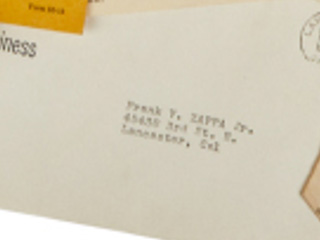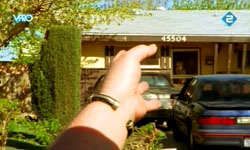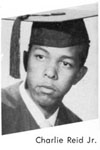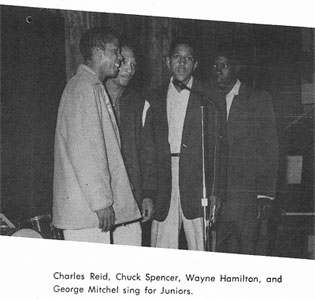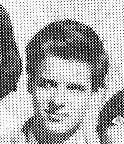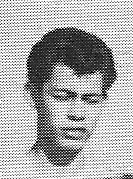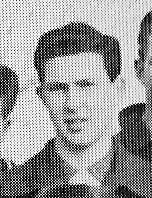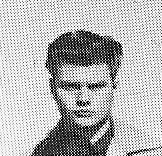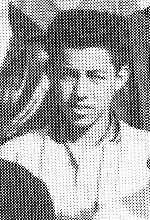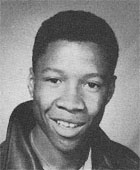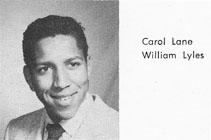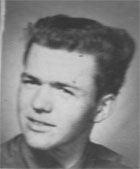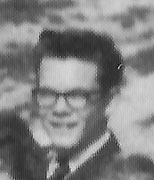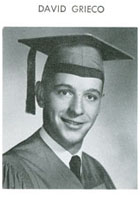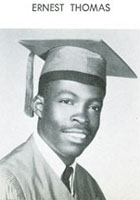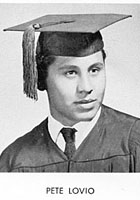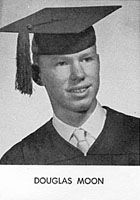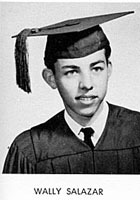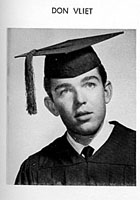Mr. Ballard, The High School Orchestra And Choir
1958 Yucca Yearbook
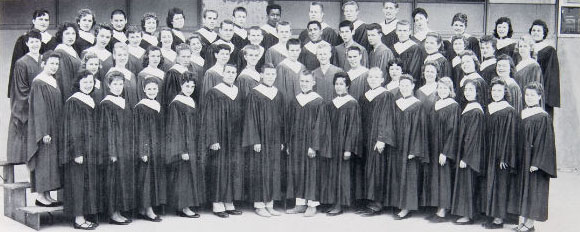
[...] Row 3: [...] Wayne Lyles [...]
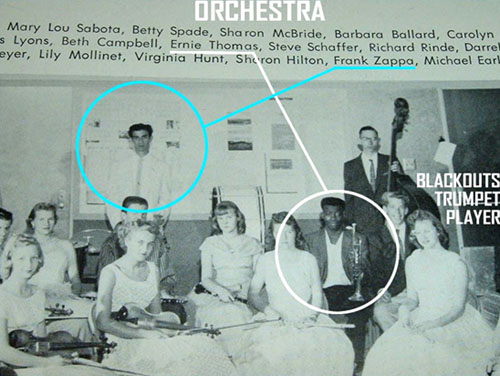

First row: Ruth Livenmore, Sharon Wilson, Mary Lou Sabota, Betty Spade, Sharon McBride, Barbara Ballard, Carolyn Kyle. Second row: Ruth Baines, Judy Roach, Jance Humble, Joan Kidd, Charles Lyons, Beth Campbell, Ernie Thomas, Steve Schaffer, Richard Rinde, Darrel Simpson, David Randell, Russell Mills, Jerry Simpson. Third row: Gwen Beckemeyer, Lily Mollinet, Virginia Hunt, Sharon Hilton, Frank Zappa, Michael Earls, Mr. Ballard.
As a kid, I knew Frank very well. We played in the school's band and orchestra together. Frank and I were probably the only music "readers" in the group.
In Lancaster I went to the high school. In 1955 I started to practice the piano. By then I played in the school band not only harmonica but also a trumpet and a tuba. At the age of fifteen I had my first performance with a country and western band playing boogie woogie style on the piano that was also recorded for one radio station.
Known as 'Butch' at school, the teenage Alexis Clair Snouffer, had a reputation around Lancaster as a tough nut. He wasn't someone you messed with. Playing trumpet in the high school band he befriended the drummer, Frank Zappa. Within a short time both had acquired guitars and were furiously practising so they could play the R&B and blues music they both liked.
Pierre Perrone, London Independent, January 2006
Born in 1941, Alexis Clair Snouffer grew up in Lancaster, California, and played trumpet in the Antelope Valley High School band, where he met Frank Zappa, who was on drums. By the late Fifties, both Snouffer and Zappa had moved on to guitar, were playing rhythm'n'blues covers in various bands and hanging out with their friend Don Van Vliet.
It started when I first met Frank. We were in the High School senior band together. He was playing drums and I played trumpet. He was a drummer. He wasn't always a guitarist. Anyway, we met, got to know each other a little bit. I suppose that it was probably within two weeks of each other we both got a guitar and started learning how to play the motherfucker. It was back in those days when if you could play Honky Tonk in ALL THREE CHANGES, hey, you were probably the best guitar man in the valley. We both were basically self-taught as far as that was concerned.
At Antelope Valley high School, his music teacher Mr. Ballard allowed him to conduct the orchestra, a job to which he brought a typically experimental approach. "A high school orchestra in those days tuned up a box which put out a tone. It had two switches, A and B flat. The B flat was used for tuning up the marching band, and the orchestra tuned to the A. So I took the first violins and tuned them to the A, and took the second violins and tuned them to B flat, guaranteeing that whatever they played would be dissonant, no matter what was on the page. "Another thing was, he had these musical staves on the blackboard, and he would let me write out these completely dense chords on the blackboard and tell all the different musicians which note of the chords was going to be theirs, then just conduct a downbeat to hear these chords. Some of them were so dense it just sounded like wind—there wasn't even any harmony coming out. But how are you going to find out what these things would sound like if you don't get a chance to hear them played by instruments? He saved me a lot of effort in later life just by letting me hear things like that. Of course, the other people in the orchestra thought I was out of my fucking mind."
Mr. Ballard was the high school music instructor at Antelope Valley High. He let me conduct the orchestra a couple of times, let me write music on the blackboard, and had the orchestra play it.
Mr. Ballard also did me a big favor without knowing it. As a drummer, I was obliged to perform the gruesome task of playing in the marching band. Considering my lack of interest in football, I couldn't stand sitting around in a stupid-looking uniform, going 'Da-ta-da-da-ta-ta-taaaah; CHARGE!" every time somebody kicked a fucking football, freezing my nards off every weekend. Mr. Ballard threw me out of the marching band for smoking in uniform—and for that I will be eternally grateful.
"I had no outlet in music then to express my discontent. So my aggravation with the way things were festered throughout my high-school years. The only reason I got training as a musician was because the school needed a marching band at its football games. It was just another tool to support the sports program. I never did enjoy sports. So I looked at all that and thought that there certainly must be more worthwhile educational investments besides new helmets. That really got me thinking—how can you take any of this seriously?"
Fortunately for Zappa, his tenure with the band didn't last long. "I was thrown out for smoking in uniform," he says while taking a drag from one of many Marlboros he would smoke that afternoon. "We had to sit in the freezing cold and wear these dorky maroon-and-gray uniforms and play every time our team scored a touchdown. So, during a break, I went under the bleachers for a smoke. I got caught and I was out of there. Not just for smoking, but for smoking in uniform."
I really have to thank Mr. Ballard (his high school music teacher) for tossing me out of the band—for smoking in uniform. Imagine that. I didn't want to be in the friggin' marching band anyway. But if you're a drummer, what do you do? What are you gonna do? Wear the hat with the chingus on the front. And it was an ugly uniform, it was maroon and grey—uuuhhh, man. Uuuuggghh. Smelly, uuuhhh, hands are cold trying to play rubbidy dub dub on an ugly sounding drum, marching, watching people play football and having to go 'Yeah!' Give me a fuckin' break. Thank you Mr. Ballard. God bless you, Mr. Ballard.
[...] I marched in parades. I hated every minute of it, but I also hated school, so it was just all one thing.
Ballard was actually sympathetic towards Frank and helped him in other ways. Zappa could never properly asess his musical compositions unless he heard them, so Ballard arranged for the school orchestra to play them. Frank wrote out the parts in chalk on the blackboard and, with him conducting, his bewildered schoolmates played their way through "The String Quartet," a composition that included the pieces known eleven years later as "Sleeping In A Jar" and "A Pound For A Brown On The Bus" when they appeared on Uncle Meat.
The First Guitar
I didn't hear any guitarists until I was about 15 or so, because in those days the saxophone was the instrument that was happening on record. When you heard a guitar player it was always a treat—so I went out collecting R&B guitar records. The solos were never long enough—they only gave them one chorus, and I figured the only way I was going to get to hear enough of what I wanted to hear was to get an instrument and play it myself. So I got one for a buck-fifty in an auction—and arch-top, f-hole, cracked base, unknown-brand thing, because the whole finish had been sanded off. It looked like it had been sandblasted. The strings were about, oh, a good inch off the fingerboard [laughs], and I didn't know any chords, but I started playing lines right way. Then I started figuring out chords and finally got a Mickey Baker book and learned a bunch of chords off that.
[...] My father played guitar when he was in college. He had an old one sitting around the house, but it didn't feel as good to me as the one for a buck-fifty. He played it about once every three years; he'd pick it up and go wank-wank-wank, but that was about all.
FZ, interviewed by Ralph Denyer, Sound International, April/May 1979
I changed to guitar when I was in Senior High School. My brother had bought this guitar for a dollar-fifty at an auction. He wasn't using it much so I started messing around on it. By that time I had gathered a bunch of records. You know, on most records in those days the instrumental or solos were always played by saxophone. It was very rarely that you would hear a good guitar solo but I searched around and found some. I thought: I really want to do that, make those sort of noises. The guitar I had to begin with wasn't electric, just one of those arched-top f-hole models. I didn't know any chords, I just started playing Blues straight away.
[...] From the very beginning when I used to hear those solos on those old records I used to say: Now here is an instrument that is capable of spewing forth true obscenity, you know? If ever there's an obscene noise to be made on an instrument it's going to come out of a guitar. On a saxophone you can play sleaze. On a bass you can play balls. But on a guitar you can be truly obscene. And that is the extent of my belief in obscenity; as far as verbal obscenity is concerned, I think that is a fantasy. But really, actually, the guitar is capable of blasphemy. Let's be realistic about this, the guitar can be the single most blasphemous device on the face of the earth. That's why I like it.
FZ, interviewed by Guitarist Magazine, June 1993
It had been kinda sandblasted! My brother got it for $1.50 at an auction and it was an archtop, f-hole, ugly motherfucker with the strings about a half-inch off the fingerboard. I liked it because it was so tinny-sounding. It was just an acoustic guitar, but it was moving closer to that wiry tone I liked with Johnny Guitar Watson, especially if you picked it right next to the bridge.
It didn't have a make on it—it had been kinda sandblasted. My brother got it for $1.50 at an auction and it was an archtop, f-hole, ugly motherfucker with the strings about a half-inch off the fingerboard.
My father had a guitar, which he kept in a closet, but I didn't really decide to mess around with the thing until we got this godawful thing at the auction. That's why I liked it, because it was so tinny-sounding. It was just an acoustic guitar, but for an acoustic instrument it was moving closer to the direction of that wiry tone I liked with Johnny 'Guitar' Watson, especially if you picked it right next to the bridge.
The guitar my father had was a round-holed guitar of anonymous make and I stuck one of those DeArmond soundhole pickups in that. So it would be one of those bad-sounding magnetic pickups that you stick in the soundhole of a normal acoustic guitar, so it wasn't a real electric guitar.
Jim Sherwood, interviewed by Billy James, T'Mershi Duween Magazine, June 1993
Frank used to sit out on the front lawn at the high school when I was a freshman and he had this old beat-up guitar. It was an old acoustic, with the frets really high. It had been in a fire and was all burnt up. I think his uncle gave it to him. Frank used to sit out and play all the time, because he was in sophomore year (that's the second one in England) and didn't have any classes, so he'd sit out and play guitar most of the time.
I found out later on that Bobby Zappa was in one of my classes. Bobby found out that I collected blues records and he introduced me to Frank, and Frank and I sort of got together and swapped records. We've been friends ever since. This was in 1956.
That's how Frank and I got in touch with each other, because I collected blues records at the time. Frank was working at [...] the record store in town [...]. Bobby (Frank's brother) took me over to the house to meet Frank and look at his record collection. Frank and I just hit it off. We were comparing blues records and songs and all that kind of stuff.
August 1957—The Composer
FZ's letter to Edgard Varèse, August 1957, from Felix Meyer (ed.), Edgard Varèse, Composer, Sound Sculptor, Visionary, The Boydell Press, 2006, p. 403-404
I have been composing for two years now, utilizing a strict twelve-tone technique, producing effects that are reminiscent of Anton Webern.
During those two years I have written two short woodwind quartets and a short symphony for winds, brass and percussion.
c. 1956-1958—The Blackouts
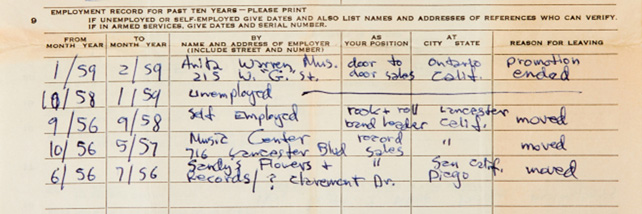
9/56—9/58—Self Employed—rock & roll band leader—Lancaster, Calif.

Terry Wimberly—? 70th St. LOH 34136, Lancaster or Quartz Hill—employed him as musician
I was getting ready to catch a bus to go home, at Antelope Valley High, and one of my classmates, Wayne Riles [Lyles], came up and said, "Hey man, this guy's startin' a band, are you interested in getting in?" Wayne knew that I had this old saxophone that I'd been playing around with for a couple years. He said, "The guy's name is Frank Zappa." I said, "Frank who?"—I'd never heard a name like that before back at that time. So he invited me to come to a rehearsal in the old Boy's Gym. So, that's my first time ever seeing Frank. [...] He had his drums set up there and I brought my little horn in. I don't know who else was there. Wayne [Lyles] at that time was our vocalist, and he played bongos. [...] So anyway—I don't know if I can put chronology to this or not—but others started joining the group. Ernie Thomas, aah, Walley [Salazar], Fred [Salazar]. [The guy that played baritone,] Jerry Reuter!
FZ's letter to Edgard Varèse, August 1957, from Felix Meyer (ed.), Edgard Varèse, Composer, Sound Sculptor, Visionary, The Boydell Press, 2006, p. 403-404
Recently I have been earning my keep at home with my blues band, the BLACKOUTS. We have done quite well and in my association with my fellow musicians I am learning to play other instruments besides drums.
When I was in high school, in Lancaster, I formed my first band, the Black-Outs. [...] This was the only R&B band in the entire Mojave Desert at that time. Three of the guys (Johnny Franklin, Carter Franklin and Wayne Lyles) were black, the Salazar brothers were Mexican and Terry Wimberly represented the other oppressed peoples of the earth.
Jerry Reutter, July 10, 2007
The band Frank was associated with prior to coming to Lancaster was a group called the 'Del Vikings' from San Diego. I remember it only because we had a battle of the bands with them and they cleaned our clock!
Frank had formed a band at that time called "The Blackouts" and he would often call Mom and ask her to pick him up from rehearsal.
Lancaster Women's Club
I can remember the first professional job I had with The Blackouts. We played in Lancaster—we were little kids. It was '57, I believe it was. Did it at a place called Lancaster Women's Club or something like that. [Corner of J and 10th.] I can remember, being kids, we all made $8 a piece (proudly). When you really figured out the time we put into it, we played four sets at forty-five minutes each. We really worked a total of three hours, not even that much.
The fact that this was an "integrated" band disturbed a lot of people. This distress was compounded by the fact that, prior to my arrival, someone had put on a rhythm-and-blues show at the fairgrounds, and legend had it that "colored people brought dope into the valley when they did that damn show, and we're never gonna let that kind of music 'round here again."
I didn't know about any of this shit when I put the band together. Anyway, my part-time job in high school was working in a record store for a nice lady named Elsie (sorry, I can't remember her last name) who liked R&B. As you can imagine, in a town like that, paying gigs for an "integrated R&B band" were few and far between. One day, I got a great idea: I decided to promote my own gig—a dance—at the local women's club hall, and I asked Elsie to help me. I wanted her to rent the hall for us, and she agreed to do so. Now, I'm pretty sure about this—it was Elsie who had promoted the original "colored-person show with optional chemical commodities"—and I didn't fully grasp the local socio-political ramifications of all this when I asked her to book the hall.
So, everything was set—the band rehearsed out in Sun Village in the Harrises' living room, we had our song list, we were selling tickets, everything was fine. The evening before the dance, while walking through the business district at about six o'clock, I was arrested for vagrancy. I was kept overnight in the jail. They wanted to keep me long enough to cancel the dance—just like in a really bad 1950s teenage movie. It didn't work. Elsie and my folks got me out.
We played the dance. It was a lot of fun. We had an enormous turnout of black students from Sun Village. Motorhead Sherwood was the hit of the evening—he did this weird dance called "The Bug," where he pretended that some creature was tickling the fuck out of him, and he rolled around on the floor, trying to pull it off. When he 'got it off,' he threw it at girls in the audience, hoping that they would flop around on the floor too. A few of them did.
The Summer Blowout
Beat The Boots II Scrapbook, p. 2
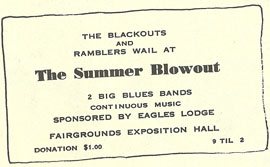
The Blackouts
and
Ramblers wail at
The Summer Blowout
2 big blues band
Continuous music
Sponsored by Eagles Lodge
Fairgrounds Exposition Hall
Donation $1.00
9 til 2
January 18, 1957—Sophomore Day Dance
1957 Antelope Valley High School Year Book
The Sophomore class led a very active schedule during this last year. [...]
The high-light of these Sophomore sponsored activities was the Sophomore Day which was held January 18th. The day's agenda included an assembly held sixth and seventh periods featuring the "Blackouts." Also included in the program were comedy acts which featured twenty of our A.V. boys dressed up as girls, daintly throwing daisies.
During the exciting Sophomore Day, the "Blackouts" set up their band in the girls' gym for the Sophomore dance. The finale of this wonderful day was the big dance that night at the Parkview Elementary School.
[...] Class officers for the first semester were: Perry Pulos, President; Nadine Reyes, Vice-President; Marcey Kloster, Secretary; Barbara Ballard, Treasurer; and Mary Donlan, Reporter.
1957 Antelope Valley High School Books' eBay seller
Frank Zappa and I attended high school at the same time, at Antelope Valley High School in Lancaster, CA. My high school boyfriend and Frank were good friends. [...] Frank Zappa's band during high school was called The Blackouts, and they played fabulous down and dirty rhythm & blues. We loved it when they were allowed to play at assemblies. They didn't play too often because we students would go crazy with joy, and the faculty thought we were having way too much fun. We loved that band!
Frank Zappa's Blackouts were never allowed to play at night-time high school dances because some of their music was just too suggestive for the faculty. So Frank organized his OWN dances at the town fairgrounds! Many of us girls were forbidden by our parents to attend the 'wild' Blackouts dances, but of course we went anyway. The dances were great fun—the lights were low, the r&b music loud, rhythmic, & wonderful, the dancing nonstop, and no chaperones! The local police always cruised by Frank Zappa's dances. After all, he was the town Bad Boy. Our own James Dean. [...]
I didn't know Frank personally, but I loved his band, The Blackouts, and was disappointed that his band wasn't allowed to play for school dances. One Saturday in 1957, the boy who lived across the street brought Frank Zappa over to my house. They asked if they could play my piano. I said sure! Wow, to have a member of the infamous Blackouts play on MY piano! Yes! They came in and played music for a long time.
[...] In this yearbook, Frank Zappa, in his Junior year, appears in two photos with his FIRST band, The Blackouts. In one photo he's playing drums. In the other photo he's on the piano.
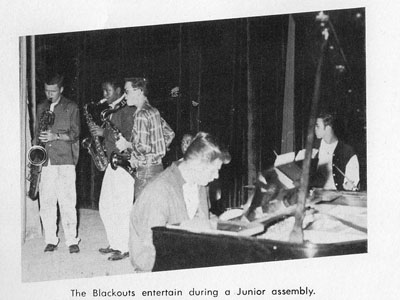
The Blackouts entertain during a Junior assembly. [Steve Wolfe, baritone sax; Johnny Franklin, tenor sax; Jerry Reutter, tenor sax; Wayne Lyles, bongos; Terry Wimberly, piano; Frank Zappa, drums.]
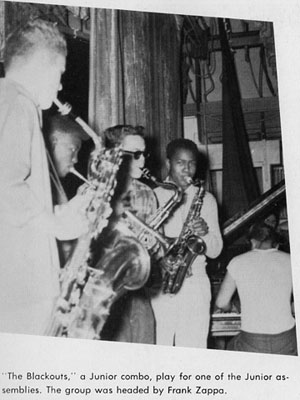
"The Blackouts," a Junior combo, play for one of the Junior assemblies. The group was headed by Frank Zappa. [on the picture, Steve Wolfe, baritone sax; Ernie Thomas, trumpet; Jerry Reutter, tenor sax; Johnny Franklin, tenor sax; Frank Zappa, piano.]
Seniors and juniors have individual portrait photos. Sophomores and freshmen are pictured alphabetically in group photos. I could not find Zappa in any other photos (other than the Blackouts pictures below). I did see John Franklin, Freddie Salazar and music notable Rex Jakabosky in the portraits and group class photo section.
Rex Jakabosky went to school at the Antelope Valley Junior High School, where he met, a.o., Frank Zappa and Captain Beefheart (Jakabosky was one year younger than Zappa). During this period Mr. Zappa was in the Blackouts, and Mr. Jakabosky sat in with the Blackouts a couple of times when their piano player couldn't make the gig. Somewhere around 1957. Mr. Jakobosky quit high school in his senior year and went to work with his father, framing houses.
Once I was at school just swifting my fingers on a piano when some boy appeared beside me. He listened for a while and than said that he liked the way I played. That's how I met with my older schoolmate Frank Zappa. We were good friends. I used to visit Frank in his apartment, we would drink coffee, smoke cigarettes and listen to the blues. He was always a personality. We played together in the school band and later for about another three years in different bands.
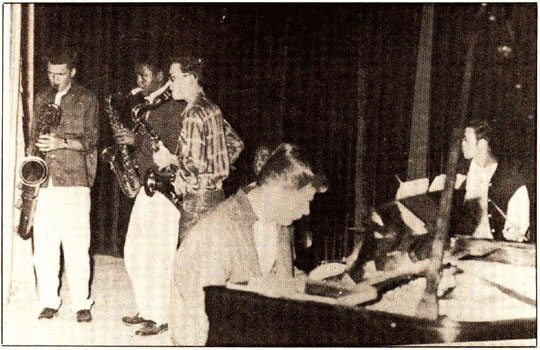
THE BLACK-OUTS, Frank Zappa's first band when he was a student at Antelope Valley High School, included members Johnny Franklin (second from left), Wayne Lyles ([fouth] from left), Terry Wimberly (at keyboards) and Zappa (at right). Two saxophone players pictured are unidentified. Other members in the band were Carter Franklin and brothers Freddie and Walter Salazar (not pictured). (ID's courtesy of Gary Lienhard and Jack Sanders.) [Steve Wolfe, baritone sax; Johnny Franklin, tenor sax; Jerry Reutter, tenor sax; Wayne Lyles, bongos; Terry Wimberly, piano; Frank Zappa, drums.]
In Lancaster there wasn't any rock and roll, unless you listened to it on a record. Most of the people who liked R&B were not the white sons and daughters of the alfalfa farmers or defense workers who lived there. There were a number of Mexicans and a lot of black kids, and they liked that kind of stuff. So I put together this racially mixed ensemble that liked to play that kind of music. We banged our heads against the wall just like every other garage band, trying to figure out how to play it. There's no guide-book.
[...] I had to mount my own events. One time we rented the Lancaster Women's Club to put on a dance. When the authorities heard that there was going to be this rock-and-roll dance in their little cowboy community, they arrested me at six that evening for vagrancy. I spent the night in jail. It was right out of a teenage movie. But the dance went off anyway.
Zappa's next experience was with the eight-piece R&B band The Blackouts, formed in 1956 while he attended Antelope Valley. This band was unusual at the time, in that it was racially integrated—three blacks (Johnny Franklin, Carter Franklin and Wayne Lyles), two Mexicans (the Salazar brothers—horn player Fred and guitarist Wally) and three whites (Zappa, pianist Terry Wimberly and unofficial member Euclid James "Motorhead" Sherwood [born May 8, 1942 in Arkansas City, KS], who used to dance "The Bug" in front of the group). Sax player Dwight Bement (an original member), saxists Steve Wolfe and Jerry [Reutter] and trumpeter Ernie Thomas also made their way through the group during its lifetime. [...]
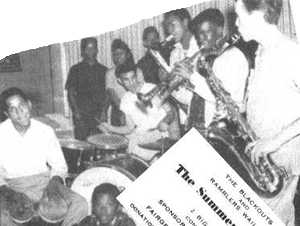
The Blackouts (l. to r.): Wayne Lyles (with bongos), Frank Zappa (drums), John Franklin (sax), Ernie Thomas (trumpet), Dwight Bement [actually probably Jerry Reutter] (sax)

The Blackouts (clockwise): Dwight Bement [actually probably Jerry Reutter], Ernie Thomas, Terry Wimberly, John Franklin, Frank Zappa, Wayne Lyles
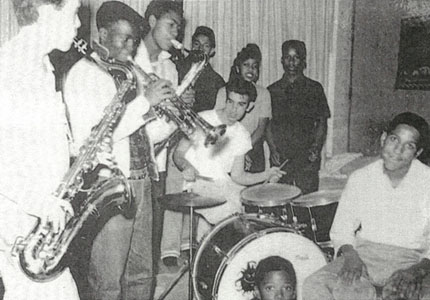
Frank on the drums with his early band The Blackouts. [From left to right: Jerry Reutter, Terry Wimberly (hidden), Ernie Thomas, Johnny Franklin, FZ, Wayne Lyles.]
Let me say that Frank and I got along OK. We played together in High School band and with our group called the Blackouts. As you probably know, Frank was an innovator. He created a thing called the "Bug." What we would do while playing, we would toss an imaginary "Bug" at people in our audience and they would go along with the "gag" and start doing this weird kind of dance, indicating that they were "overcome" with this bug thing. [...] Again, the only time I ever heard from Frank Zappa after graduating from High School was through mutual friends who stayed in touched with him.
Alex Snouffer, quoted in the Grow Fins booklet, 1999
[FZ] started his band, the Blackouts, and he had guys like Junior Madeo playing with him and Steve Wolfe, and Jerry [Reutter], and Johnny Franklin on horns, I forget who all was in the band.
When did you get your first band together?
When I was in high school before starting on the guitar. It was a group called the Blackout . . . in Antelope Valley High School. It was a funny small town—Lancaster. They had had a bad experience about 1954, prior to the time I moved into the valley. Joe Houston and Marvin & Johnny and some others came in and did a R&B show. This was the first time any people in that part of the world had ever seen R&B. And of course with the groups came the dope peddlers and the town was really scared.
In those days the police were afraid of teenagers. It was a bad scene. Gang fights and all that. Then I came to town. I had been working with an R&B group in San Diego. I got a band together and we stayed together long enough to learn ten songs. There was a Negro settlement outside of town called Sun Village and it was those people who supported the group. We had these huge Negro dances and this upset the people in the town. The police arrested me for vagrancy the night before one show and I was in jail overnight.
My parents bailed me out. The band stayed together until everybody got to hate each other's guts.
Band members would pick through used jukebox 45-rpm records at a Lancaster store, looking for old-time blues musicians and the bands and company labels they liked.
Zappa listened to the records, figured out each instrument's part and explained to his bandmates what to play.
"I don't know how and when he learned his music theory," said Fred Salazar, a 1959 Antelope Valley High graduate who played saxophone in Zappa's bands. "He impressed me when I first met him. He seemed to know music. He was so comfortable with it."
And just like in any rock 'n' roll movie from the 1950s, the bands—The Blackouts and The Omens—and their music were unpopular with many parents and with the people who rented them halls to hold dances.
"They looked at us as kind of bad," said Salazar, who stayed in Antelope Valley after high school and now is a retired Edison electrician. "We were just out to enjoy ourselves and play the kind of music we liked."
Band member Peter Lovio remembers riding with Zappa in the 1949 Oldsmobile of Don Van Vliet—later rock band leader Captain Beefheart—when Van Vliet was pulled over on Sierra Highway and given a ticket for driving too slowly.
The deputies pulled things out of the car and out of its trunk and threw them on the ground, Lovio said, then told the teens they could go.
"That happened more than once," Lovio said. "We were like outcasts. We dressed different. We looked different. We were continually harassed."
The bands' members included African-Americans and Latinos, back in the days when the Antelope Valley's population was almost entirely white and most African-Americans lived in Sun Village (about which Zappa recorded a song in 1972).
"The neighbors would kind of look at us: here comes a car with a bunch of black kids into the neighborhood," Lovio said.
But Salazar also remembers Zappa performing solo on guitar for an Antelope Valley High assembly, and Lovio said the Omens became accepted enough, after Zappa left Lancaster, to be invited to perform at the Antelope Valley Fairgrounds.
I got my own little band together. The name of this band was The Blackouts. And they were called The Blackouts because they would literally black out after the show from drinking peppermint schnapps.
This was a rowdy sort of a teen-age band and it was the only rhythm & blues band in the desert area where I was living. [...] And we were the only rhythm & blues band that was in that area, and consequently we had a lot of trouble with the police department. The reason for that was that in 1955 or '56, a woman named Elsie Page who ran the record store where I used to work had the unmitigated audacity to try and promote a real live rock 'n' roll show, there, in the Antelope Valley. And I think she brought Joe Houston and, uh, Marvin & Johnny and a few of the other big R&B people at that time—brought them to the Antelope Valley, and with them came DOPE PUSHERS.
Several people were caught possessing mysterious red pills. And they passed out and everything. So the police and the civic leaders swore that this dreadful music should never be allowed into the area again. Well, I didn't know this; this had happened before I got there.
So I had this band and the day [before] we were going to play our first concert, at six o'clock in the afternoon, I was arrested for vagrancy walking down the street. And I didn't understand what was going on. They kept me overnight, gave me some really terrible pancakes, and let me out just in time to play the show.
Don Menn & Matt Groening, "The Mother Of All Interviews, Part 2," Zappa!, 1992
MG: You were in a band at that time, too, right? [...]
[...] I didn't know when I moved to Lancaster that, prior to my arrival, there had been an unfortunate experience with "Negroes" in the area. A group of black entertainers had come up from what they call "down below," the evil area below the high desert. They had come up. It was Big Jay McNeeley and a bunch of other entertainers that had come to do a rock show at the fairgrounds, and along with them came people who were selling reefers and pills, and the founding fathers of the city decided never again shall this music enter our fair cowboy area. I didn't know any of this had happened. I moved there from San Diego, and put a rhythm and blues band together, and decided to throw my own dance, and put up little posters just like in the 1950 movies with the help of this lady who ran the local record store. Her name was Elsie. We rented the women's club, and we were going to have our little dance there. And the day before the dance, walking down Lancaster Boulevard at 6:00 o'clock in the evening, I was arrested for vagrancy. They kept me in jail overnight, trying to make sure this dance wasn't going to come off.
DM: How old were you?
Seventeen.
MG: So what happened?
I got out, and we had the dance.
MG: And civilization didn't fall.
It didn't fall. And furthermore, the dance—see, all of the black people in the area lived out in Sun Village, like 20 or 30 miles away from the school. They were in their own little turkey-infested ghetto, and they came to this dance, because I had a mixed band. There was a couple of blacks, a couple of Mexicans. You know, there weren't that many white-bread people who could play anything that resembled rock and roll in the area, so we just had this hodgepodge band. The whole attitude of that area up there was very strange. After the dance there was what could have turned into a really unfortunate confrontation with the lettermen from the school, the varsity white-bread boys, who wanted to beat me and the band up after the show as we were loading our equipment. It was so unbelievably hokey. The Sun Village residents came to our rescue. When they saw what was happening, trunks started opening up and chains started coming out and things like that, and the lettermen walked away.
It was comprised of Johnny Franklin, Peter Lovio, Wally Salazar, and a couple other guys for which I don't remember their names.
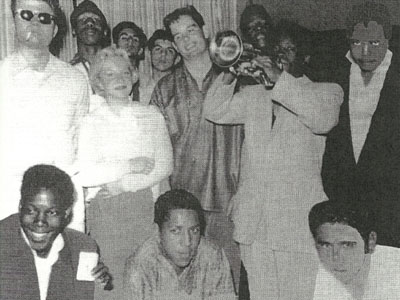
This very rare photo of Frank with The Blackouts is not in the greatest shape, but it does show Frank's girlfriend, Sandy Van Kamp. Bob is next to Frank. [From left to right, standing: Terry Wimberly?, Johnny Franklin?, Sandy Schvanekamp, FZ, Bobby Zappa, ?, Carter Franklin?, Ernie Thomas, Fred Salazar?; seated: ?, Wayne Lyles, Wally Salazar?]
When I came up here, I came up here looking for Mexican guys—Hispanics, and the only ones I could find were this guy (points to Wally Salazar) and his brother (Fred) and they were the only ones wearing khaki pants [...]. How many blacks were there? Not many. [...] Because of these guys here, Johnny [Franklin], and the black guys, I became friends with the Mexicans and the black guys and that's where Frank (came in) . . . those were his friends. He didn't socialize with the white kids, other than Jim Sherwood and Don Ferize and a couple of other guys.
The fact that this was an "integrated" band disturbed a lot of people. This distress was compounded by the fact that, prior to my arrival, someone had put on a rhythm-and-blues show at the fairgrounds, and legend had it that "colored people brought dope into the valley when they did that damn show, and we're never gonna let that kind of music 'round here again."
I didn't know about any of this shit when I put the band together. Anyway, my part-time job in high school was working in a record store for a nice lady named Elsie (sorry, I can't remember her last name) who liked R&B. As you can imagine, in a town like that, paying gigs for an "integrated R&B band" were few and far between. One day, I got a great idea: I decided to promote my own gig—a dance—at the local women's club hall, and I asked Elsie to help me. I wanted her to rent the hall for us, and she agreed to do so. Now, I'm pretty sure about this—it was Elsie who had promoted the original "colored-person show with optional chemical commodities"—and I didn't fully grasp the local socio-political ramifications of all this when I asked her to book the hall.
So, everything was set—the band rehearsed out in Sun Village in the Harrises' living room, we had our song list, we were selling tickets, everything was fine. The evening before the dance, while walking through the business district at about six o'clock, I was arrested for vagrancy. I was kept overnight in the jail. They wanted to keep me long enough to cancel the dance—just like in a really bad 1950s teenage movie. It didn't work. Elsie and my folks got me out.
We played the dance. It was a lot of fun. We had an enormous turnout of black students from Sun Village. Motorhead Sherwood was the hit of the evening—he did this weird dance called "The Bug," where he pretended that some creature was tickling the fuck out of him, and he rolled around on the floor, trying to pull it off. When he 'got it off,' he threw it at girls in the audience, hoping that they would flop around on the floor too. A few of them did.
After the dance, as we were packing our stuff into the trunk of Johnny Franklin's wasted blue Studebaker, we found ourselves surrounded by a large contingent of lettermen (The White Horror), eager to cause physical harm to our disgusting little 'integrated band.' This was a mistake because, upon seeing the Gathering of the Ugly Jackets, a few dozen 'Villagers' started hauling chains and tire irons out of their trunks, with a look in their eyes that said, "The night is young."
The lettermen folded, in total humiliation—God, they're so sensitive about that sort of thing—and went home to their coots & codgers. They remained hostile to me and the other guys in the band all the way through to graduation.
Zappa formed a band called The Blackouts which Alex may or may not have played with. But when it disbanded in 1958 Alex got together with some of the ex-members to form The Omens, a good time partying R&B group.
One time I sang "Riot in Cell Block #9" with the Blackouts at the Antelope Valley fair.
There were only a couple of original songs. One of them was called "The Omen." And another one was called "Palm City Rock." And most of the rest of the material was instrumental versions of rhythm & blues records which were not particulary current but had been released in, you know, a period five years prior to our forming of the band, songs like "Behind The Sun," which was originally recorded by The Rockin' Brothers on Imperial, and "Okie Dokie Stomp" that was done by Clarence Gatemouth Brown on Peacock, and stuff like this, pretty obscure material. But the people who liked rhythm & blues knew these songs.
And we had maybe a song list of twenty tunes. And if we were running out of songs and the dance wasn't done yet, we would just stretch 'em out or play one of the earlier ones again, 'cause we didn't have chance to rehearse a lot.
The Black-Outs learned ten songs, including "Kansas City," "Behind The Sun" by the Rockin' Brothers, Clarence "Gatemouth" Brown's "Okie Dokie Stomp," Little Richard's "Directly From My Heart To You" and André Williams and His New Group (the Don Juans)'s "Bacon Fat"—also known as "Diddle Diddle Womp Womp."
Charles Ulrich, August 23, 2014
I talked with John Franklin on the phone.
Carter Franklin played harmonica and sang in The Blackouts.
Stan "Corky" Mitchell played tenor saxophone in The Omens.
My cousin, Sonny—whose name was Freddy Louis [Lewis], we called him Sonny—he had bought a guitar, and this is before Frank had even messed with a guitar—he had this guitar—I think it was called a Gibson Les Paul Junior. It was a solid body as heavy as all get-out. Somehow, he brought that to the rehearsal and we all messed around with it, you know. Kids got a new instrument, you know. We were out in Frank's garage. I started messin' with it, Sonny messed with it, I don't know who all messed with it, but somehow I hit a coupla' notes on it accidentally, and he (Frank) said, "Hey, lemme try that." So I handed if to him, and he started messin' with it and, I think he liked it. Then he started switching off—guitar, drummer . . .
June 22, 1957—The Blackouts At The NAACP 7th Annual Festival, Shrine Exposition Hall
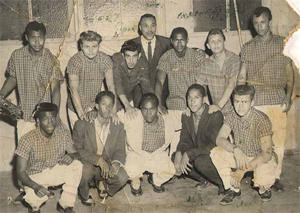
This picture appeared on the Internet around February 2001.
When I moved to Lancaster I put my own band together, called the Blackouts, and I was still playing drums. The biggest gig we ever had was at the Shrine Exposition Hall for an NAACP benefit; we were the warm-up act to Earl Bostic. The people weren't dancing to Earl Bostic for some reason, so he hung it up, and we went back out there and played. Everybody was jumping all over the place.
I found this article and ad dated on June 13, 1957 (the ad is repeated on June 20, 1957) where I think the Blackouts opened for Earl Bostic Orchestra at the Shrine Exposition Hall on June 22, 1957. Other artists included were: Red Nichols and his Five Pennies, the Velvetones, Little Richard & The Platters.

Special Activities Branch of NAACP
—presents Seventh Annual—
FESTIVAL OF STARS
Red Nichols "5" Pennies
Velvetones
"Little" Richard
The Platters
Dance Music by Earl Bostic Ork.
Sat., June 22, 9 P.M. Until
Shrine Hall, 32nd & Royal
Donation $2.00
At door $2.50
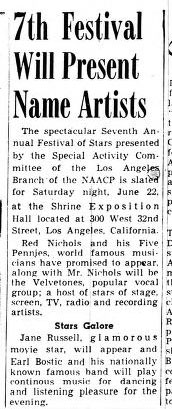
7th Festival Will Present Name Artists
The spectacular Seventh Annual Festival of Stars presented by the Special Activity Committee of the Los Angeles Branch of the NAACP is slated for Saturday night, June 22, at the Shrine Exposition Hall located at 300 West 32nd Street, Los Angeles, California.
Red Nichols and his Five Pennies, world famous musicians have promised to appear, along with Mr. Nichols will be the Velvetones, popular vocal group; a host of stars of stage, screen, TV, radio and recording artists.
Stars Galore
Jane Russell, glamorous movie star, will appear and Earl Bostic and his nationally known famous band will play continous music for dancing and listening pleasure for the evening.
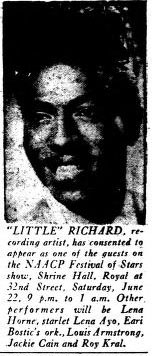
"LITTLE" RICHARD, recording artist, has consented to appear as one of the guests on the NAACP Festival of Stars show, Shrine Hall, Royal at 32nd Street, Saturday, June 22, 9 p.m. to 1 a.m. Other performers will be Lena Horne, starlet Lena Ayo, Earl Bostic's ork., Louis Armstrong, Jackie Cain and Roy Kral.
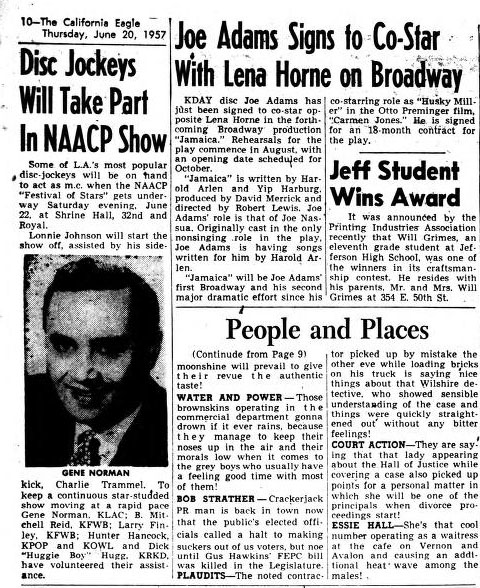
Disc Jockeys Will Take Part In NAACP Show
Some of L.A.'s most popular disc-jockeys will be on hand to act as m.c. when the NAACP "Festival of Stars" gets underway Saturday evening, June 22, at Shrine Ahll, 32nd and Royal.
Lonnie Johnson will start the show off, assisted by his sidekick, Charlie Trammel. To keep a continuous star-studded show moving at a rapid pace Gene Norman, KLAC; B. Mitchell Reid, KFWB; Larry Finnley, KFWB; Hunter Hancock, KPOP and KOWL and Dick "Huggie Boy" Hugg, KRKD, have volunteered their assistance.
Charles Ulrich, August 28, 2012
Thirteen minutes into the 9/13/70 Miles interview, FZ says that when The Blackouts opened for Earl Bostic at the Shrine Auditorium, they were an eight-piece band. "One guy was half Sicilian and half Indian. We had two Mexicans. And me and one other guy were the whiteys in the band. And all the rest of the guys were black."
The Sicilian-Indian Blackout must have been [Elwood "Junior"] Madeo. Miles (p. 28) says that Madeo was "also known as 'Bomba the Jungle Boy' because of his Indian-Italian parentage."
Charles Ulrich, May 15, 2013
I think "Charles Reeves" of The Blackouts is really Charlie Reid Jr. of the AVJUHS class of '57 [see detail below]. [...] I think Charlie Reid is in the front row next to Ernie Thomas. [...] Javier Marcote [...] agrees that these two photos show the same person. [...] If that's Charlie Reid, then Sonny [Lewis] must be between him and Wayne Lyles. And the unidentified Blackout next to Elwood Madeo may be Steve Wolfe.
Sharva Maynard, February 13, 2007
Regarding the band photo: Terry Wimberly is second from left, top row. Jerry Reutter is front row right end. [...] Fred and Wally [Salazar] are not in that band photo.
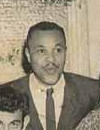
Joe Adams
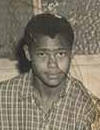
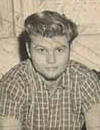
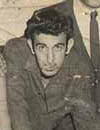
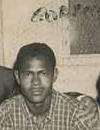
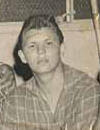

Johnny Franklin, Terry Wimberly, Frank Zappa, Carter Franklin, unidentified (Stan "Corky" Mitchell?), Elwood Madeo.

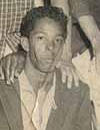
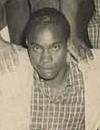
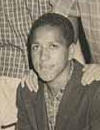
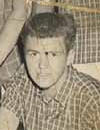
Ernie Thomas, Charlie Reid Jr., Freddy "Sonny" Lewis, Wayne Lyles, Jerry Reutter.
Charles Ulrich, August 23, 2014
[John Franklin] confirmed all of Román's identifications of the band members in the photo with Joe Adams. But unfortunately he didn't recognize the guy next to Elwood Madeo. He said it could be Stan "Corky" Mitchell (previously mentioned as a member of The Omens, not The Blackouts).
He identified Charles Reid as "guest vocalist" and Freddie Lewis as "equipment facilitator".
Some friends of The Blackouts
Frank had a band at that time called the Blackouts. I went over and saw them at the Moose Lodge or something, and the group disbanded right after that.
Bill Harkleroad, interviewed by Joe Gore, Guitar Player Magazine, January 1, 1998
One of the first bands I remember seeing live was the Blackouts with Frank on drums. When I was 14 or 15 and Frank and Don [Van Vliet] were in their early 20s, I started meeting them at jam sessions.
Bill Harkleroad, interviewed by David Gabrielsen, DISCoveries vol.1 #7, December 1, 1988
I grew up in the same town [as Don Van Vliet]. I used to see his group and Zappa, when he was just starting out, in a group called The Blackouts, playing dynamite blues guitar. They would rehearse in the Junior High gymnasium, and I'd sneak in and listen to them. Here were these old guys and a nineteen-year-old playing this blues music.
The first time I ever heard a live band was in an assembly at Antelope Valley Joint Union High School (AVJUHS). The band was The Blackouts: Frank Zappa on drums; Terry Wimberly on piano; Fred [Salazar] on baritone sax; Fred's brother Wally on guitar; and three soulful vocalists, Henry Strawberry, Chuck Spencer, and a third singer whose name I don't recall at the moment but I will get it from my yearbook. At the time that was the first mixed band I or anyone else had EVER seen. From that time on I knew exactly what I wanted to do in my life.
I was just the guy who got them from point A to point B. I was not in the band at all. I didn't play anything. I was transport. I remember Wally Salazar . . . Terry Wimberly . . . Frank, drums. Who knows bass? I don't even know if there was one.
I got connected in all this when I was a freshman in High School and Frank was a senior. [...] I was studying radio and electronics, and stuff. It was my nature. I met this guy—Steve Wolfe's brother. He was kind of a nerd, an electronics geek. I went over to his house one time and his brother Steve was a sax player in The Blackouts. [...]
Frank was the drummer. I guess Terry Wimberly was in there and Johnny Franklin and you know all the others. I had always been interested in music and playing an instrument but I never had gotten close enough to get my hands on an instrument, or close enough to where I could get into it. [...] Anyway, I went over there and (The Blackouts) were having a band practice at Steve's house—so I got to meet the band. Steve Wolfe, the sax player and I struck up a friendship. I used to hang out, and every time there was a practice, I'd go to their practice, and I'd go to their gigs and stuff. I even cut school a couple of times to go to their gigs. I remember getting in trouble for it.
August 1957—Baltimore, MD
[FZ] wanted to see some of the world, and his mother suggested a trip back to Baltimore to visit his relatives. Frank wrote Aunt Mary to get the OK.
"Besides sending thanks, this letter is going to be kind of a questionnaire," he wrote. "The question being, 'Could you find some space for me if I were to come and visit you and Uncle Robert?' . . . The reason for the trip is two-fold. Firstly, I would like to see the East again and all the relatives (most of which I probably couldn't recognize by face at all) back there.
"The second reason is that I think I have invented something new in the way of music (probably not) which I would like to take to the conservatory back there for investigation. If I did come I would not stay long, and I would help out around the house any way I could, so please consider this request and write soon."
Aunt Mary opened her home at 4805 Loch Raven Blvd. to her nephew and soon Zappa was traveling the length of the country on a train. Finally emerging from Penn Station, he said that:
"My relatives were shocked to see the way I looked. They were all so horrified that I think I was an embarrassment to them.
[...] Zappa hoped to travel to New York to visit French-born composer Edgar Varèse (1883-1965), an early and perhaps most major influence, during his East Coast trip, but the older man was not available.
[...] An insufficient consolation, however, was an introduction to Massimo Freccia, at the time the conductor of the Baltimore Symphony Orchestra, now in retirement in London.
He brought along his "new" music, a foreshadowing of the trademark Zappa pastiche of this and that, culled from here and there.
"I had brought manuscript paper to Maryland and was writing orchestra music at Aunt Mary's house," he said. "I was naive and thought [Freccia] could play it. He looked at [my appearance] and couldn't believe I was writing orchestra music."
Instead of discussing the earnest but somewhat crude Zappa compositions, Freccia instead quizzed the youngster with questions like: "What's the lowest note on the bassoon?" The relationship ended there.
December 4, 1957
On 4 December 1957, just before his seventeenth birthday, [FZ] sold part of his drumming equipment, and hired out another part to another local band called The Bluenotes; the contract for that deal is another of the biographical artefacts Zappa has kept to this day.
April 19, 1958—"Family Room"
Winner of the state wide art competition sponsored jointly by the California Federation of Women's clubs and the Hallmark Greeting Card company is Frank Zappa of Lancaster, son of Mr. and Mrs. Frank Zappa, 45438 Third St. East.
Young Zappa was the honored guest Saturday at a tea in the Jack Carr galleries in South Pasadena where he was presented with the award for his painting. An abstract, it is entitled "Family Room." [...]
Currently, he is in Shirley Eilers' class at the Lancaster high school.
[...] A performer on the drums, vibes and guitar, he is the former leader of the jazz combo known as the "Blackouts."
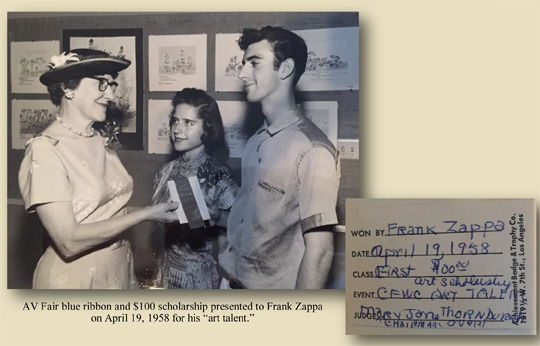
AV Fair blue ribbon and $100 scholarship presented to Frank Zappa on April 19, 1958 for his "art talent."
WON BY Frank Zappa
DATE April 19, 1958
CLASS First $100.00 art scholarship
EVENT CFWC Art Talent
JUDGES Mary Jane Thornburg chairman (over)
June 13, 1958—Graduation
I graduated from Antelope Valley High School, Lancaster, California on Friday, June 13, 1958 (with about twenty units less than what was required, simply because they were in a hurry to get rid of me)—
I remember well the night he graduated from high school. It was 1958. We were all dressed up in our Sunday-go-to-meetin' clothes and I was so happy to see Frank in that cap and gown. It was quite a change from the chinos and T-shirts that he always wore. He was smiling and waving his diploma.
The following information is gleaned from a radio show Frank is putting together for distribution. [...] Frank began playing guitar in 1958. He graduated from high school the same year and attended one semester of Jr. College before "finding someone to live with and dropping out."
1958 Antelope Valley High School Book

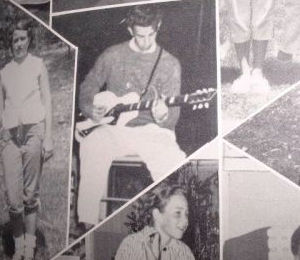
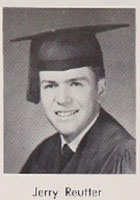
Jerry Reutter
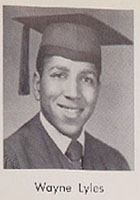
Wayne Lyles
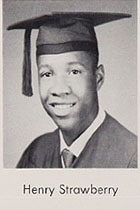
Henry Strawberry
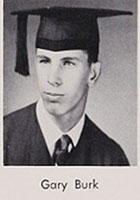
Gary Burk [Gary Burkey?]
1960 Supro Dual Tone, manufactured by Valco
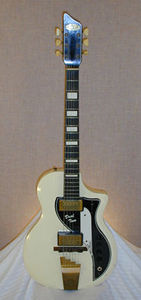

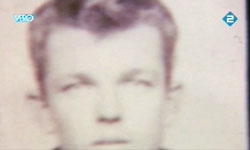
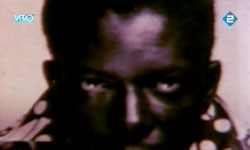
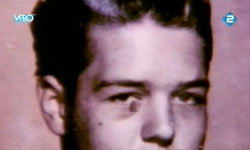
[Junior Madeo, Don Vliet?, Ernie Thomas?, ?]
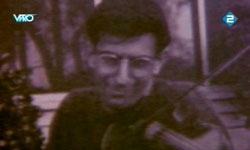
[unidentified violinist: FZ?]
Additional informants: Tan Mitsugu, Javier Marcote (special thanks to Javier for finding and providing so much material), Michael Dawson

